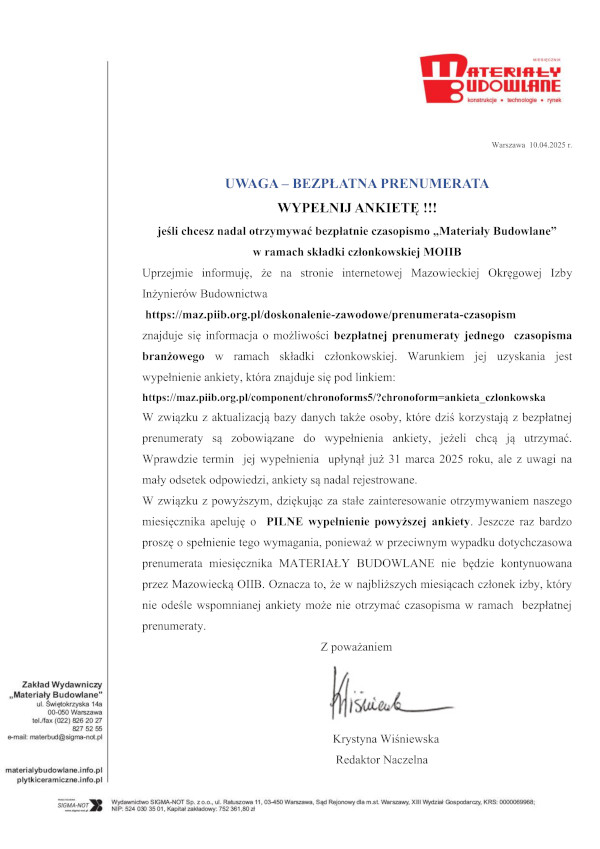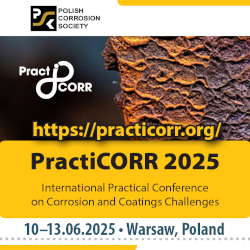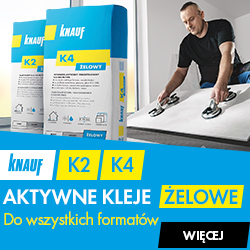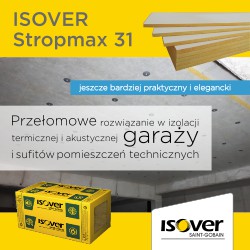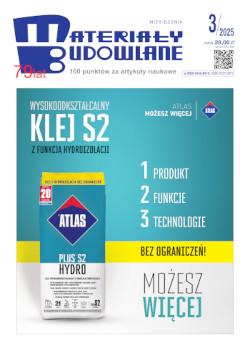mgr inż. Maciej Kalinowski, Politechnika Warszawska; Wydział Inżynierii Lądowej
ORCID: 0000-0002-6729-1506
prof. nzw. dr hab. inż. Piotr Woyciechowski, Politechnika Warszawska; Wydział Inżynierii Lądowej
ORCID: 0000-0002-8127-7559
Adres do korespondencji: Ten adres pocztowy jest chroniony przed spamowaniem. Aby go zobaczyć, konieczne jest włączenie w przeglądarce obsługi JavaScript.
DOI: 10.15199/33.2019.07.07
Oryginalny artykuł naukowy (Original research paper)
Jedną z niedawno wprowadzonych grup dodatków do betonu są polimery superabsorpcyjne (SAP). Ich zastosowanie, jako środka wewnętrznej pielęgnacji wodnej betonu, pozwala na znaczną redukcję zmian liniowych spowodowanych zjawiskami skurczowymi, poprawiając w ten sposób trwałość materiału. Wpływ SAP na parametry mechaniczne, takie jak wytrzymałość na ściskanie, nie jest już tak jasno określony. W związku z tym przebadano dziesięć składów mieszanek betonowych modyfikowanych dwoma rodzajami SAP. Przebadane mieszanki różniły się również metodą dozowania SAP, tj. kinetyką desorpcji wody z zastosowanego dodatku. Celem badań było określenie wpływu zmiennych, jakimi były różnice w metodzie dozowania SAP, absorpcyjności zastosowanych polimerów oraz mechanizmie absorpcji i desorpcji wody zarobowej przez SAP na wytrzymałość na ściskanie kompozytów betonowych oraz konsystencję i gęstość objętościową mieszanki betonowej. Na podstawie otrzymanych wyników stwierdzono, iż kinetyka desorpcji wody z SAP w mieszance betonowej oraz różnice we właściwościach zastosowanych polimerów superabsorpcyjnych mają duży wpływ na przebieg zmian badanych właściwości betonu.
Słowa kluczowe: kompozyty betonowe; polimery superabsorpcyjne; absorpcja; desorpcja; wytrzymałość na ściskanie.
The influence of the water desorption kinetics from superabsorbent polymers on the compressive strength of cement composites
Abstract. One of the recently introduced groups of additions to the concrete technology is group of superabsorbent polymers (SAP). Their use, as a means of internal water curing agent, allows for a significant reduction of linear changes caused by shrinkage deformations, thus improving composites durability.The influence of SAP on the mechanical parameters, such as compressive strength, is not as clearly defined. As part of a research program, ten compositions of concrete mixtures modified with two types of superabsorbent polymers were tested. The tested mixtures also differed in the SAPdosingmethodology, i.e. the desorption kinetics of the additive used. The aim of the study was to determine the effects of variables, such as differences in the SAP dosingmethod, SAP’s absorption potential and its absorption and desorption mechanics on the formation of selected properties of concrete – compressive strength and consistency of the concrete mix. Based on the obtained results, it was found that the SAP desorption kinetics in the concretemix and the differences in properties of the tested superabsorbent polymers have a significant influence on the course of changes on the tested concrete properties.
Keywords: concrete composites; superabsorbent polymers; absorption; desorption; compressive strength.
Literatura
[1] Farzanian Khashayar, K. Pimenta Teixeira, I. Perdiago Rocha, Leticia De Sa Carneiro, Ali Ghahremaninezhad. 2015. „The mechanical strength, degree of hydration and electrical resistivity of cement pastes modified with superabsorbent polymers”. Constr. Build. Mater. 109: 156 – 165.
[2] Hasholt Marianne, Ole M. Jensen. 2015. „Chloride migration in concrete with superabsorbent polymers”. Cem. Concr. Compos. 55: 290 – 297.
[3] Jensen Ole M., Per F. Hansen. 2001. „Water entrained cement-based materials; I. Principles and theoretical background”. Cem. Concr. Res. 31: 647 – 654.
[4] Justs Janis, Mateusz Wyrzykowski, Diana Bajare, Pietro Lura. 2015. „Internal curing by superabsorbent polymers in ultra-high performace concrete”. Cem. Concr. Res. 76: 82 – 90.
[5] Kang Sung-Hoon, Sung-Gul Hong, JuhyukMoon. 2017. „Absorption kinetics of superabsorbent polymers (SAP) in various cement-based solutions”. Cem. Concr. Res. 97: 73 – 83.
[6] Mechtcherine Victor, Hans-Wolf Reinhardt. 2012. „Application of Superabsorbent Polymers (SAP) in Concrete Construction”. State-of-the-Art Report Prepared by Technical Committee 225-SAP. Springer Science & Business Media: Berlin, Germany.
[7] Mignon Arn, Geert-Jan Graulus, Didier Snoeck, J. Martins, Nele De Belie, Peter Dubruel, Sandra Van Vlierberghe. 2014. „pH-sensitive superabsorbent polymers: Apotential candidate material for self-healing concrete”. J. Mater. Sci. 50: 970 – 979.
[8] Olawuyi Babatunde J., Willian P. Boshoff. 2017. „Influence of SAP content and curing age on air void distribution of high performance concrete using 3D volume analysis”. Constr. Build. Mater. 135: 580 – 589.
[9] PN-EN 197-1:2012 Cement – Część 1: Skład, wymagania i kryteria zgodności dotyczące cementów powszechnego użytku. Composition, Specifications and Conformity Criteria for Common Cements; European Comittee for Standardization: Brussels, Belgium, 2011.
[10] PN-EN 12620+A1:2010 Kruszywa do betonu.
[11] Pourjavadi Ali, Seyed M. Fakoorpoor, Payam Hosseini, Alireza Khaloo. 2013. „Interactions between superabsorbent polymers and cement-based composites incorporating colloidal silica nanoparticles”. Cem. Concr. Compos. 37: 196 – 204.
[12] Schrofl Christof, Victor Mechtcherine, Michaela Gorges. 2012. „Relation between the molecular structure and the efficiency of superabsorbent polymers (SAP) as concrete admixture to mitigate autogenous shrinkage”. Cem. Concr. Res. 42: 865 – 873.
[13] Snoeck Didier, Kim Van Tittelboom, Stijn Steuperaert, Peter Dubruel, Nele De Belie. 2014. „Self-healing cementitious materials by the combination of microfibres and superabsorbent polymers”. J. Intell. Mater. Syst. Struct. 25: 13 – 24.
[14] Snoeck Didier, Leticia F. Velasco, Arn Mignon, Sandra Van Vlierberghe, Peter Dubruel, Peter Lodewyckx, Nele De Belie. 2015. „The effect of superabsorbent polymers on the microstructure of cementitious materials studied by sorption experiments”. Cem. Concr. Res. 77: 26 – 35.
[15] Snoeck Didier, David Schaubroeck, Peter Dubruel, Nele De Belie. 2014. „Effect of high amounts of superabsorbent polymer and additional water on the workability, microstructure and strength of mortars with water-to-cement ration of 0.50”. Constr. Build. Mater. 72: 148 – 157.
[16] Song Chiwon, Young Cheol Choi, Seongcheol Choi. 2016. „Effect of internal curing by superabsorbent polymers – Internal relative humidity and autogenous shrinkage of alcali-activated slag mortars”. Constr. Build. Mater. 123: 193 – 206.
[17] Woyciechowski Piotr,Maciej Kalinowski. 2018. „The influence of Dosing Method and Material Characteristics of Superabsorbent Polymers (SAP) on the Effectiveness of the Concrete Internal Curing”. Materials (11): 1600.
Przyjęto do druku: 16.04.2019 r.
Materiały Budowlane 7/2019, strona 47-51 (spis treści >>)


